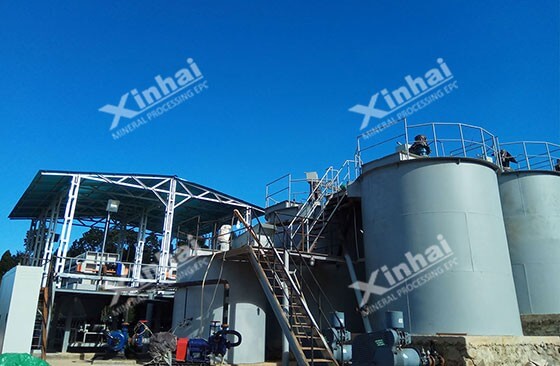

Warm Tip: If you want to know more details about equipment, solutions, etc, please click the button below for free consultation, or leave your requirements!
Gold cyanidation (also known as the cyanide process or the MacArthur-Forrest process) is a hydrometallurgical technique for extracting gold from low-grade ore by converting the gold to a water-soluble coordination complex. It is the most commonly used leaching process for gold extraction.
In most cases, gold is often physically wrapped or incorporated into the various chemical compounds, which leads to gold cannot contact with the cyanide solution and difficult to be leached. Depending different gold associated minerals, how to improve the effect of gold cyanidation Process?
Let's start.

This kind of ore is the associated minerals that can consume oxygen, alkali and cyanide. It is easy to be oxidized and decomposed, then the sulfate, ferrous sulfate, ferric subsulfate and ironthiosulfate are generated. The decomposed material can react with cyanide oralkali, causing a large number of oxide, cyanide and alkali dissolved before the dissolving, thus hampering the gold cyanidation.
For this kind of problems, pre-aerated alkali leaching method is often adopted, that is, filling oxygen and agitating in the alkaline medium before the pulp cyaniding leaching, so that these minerals have enough oxidation and hydrolysis time to convert into the cyanide ferric hydroxide that cannot be dissolved by the cyanide, then adding the cyanide to effectively dissolve the gold.
Some gold ores contain active organic carbon or graphite. Because the carbon in the gold ore is quite active, it can absorb the dissolved gold, and then precipitate again, thus reducing the rate of gold cyanidation Process.
According to the carbon content of this kind of ore, two kinds of methods can be used: physical mineral processing and chemical mineral processing.
Physical mineral processing method:Refueling and floating gold ore when the carbon content is high; When the carbon content is low, adding the moderate organic matter (such as kerosene or coal tar) before the leaching according to the hydrophobicity of carbon mineral surface, which can make the carbon mineral surface form a layer that inhibits the adsorption of dissolved gold, weaken the ability of gold absorption and eliminate the influence of carbon on the gold leaching.
Chemical mineral processing method:Using the sodium hypochlorite to make the gold ore oxidize in the alkaline medium at 50~60℃. Otherwise, adopting the roasting method to oxidize the carbon to carbon monoxide and carbon dioxide, and then the gold is extracted by the cyaniding leaching process.

Some of the gold ores are associated with copper and zinc mineral, such as malachite, azurite, chalcocite, sphalerite(especially the oxidizing sphalerite), etc.These minerals have a high solubility in the cyanide solution. When the gold is leached, they will contend the cyanide and oxygen with the gold, thereby preventing the dissolution of gold and decreasing the cyaniding efficiency.
For such cases, the different treatment methods can be adapted according to the content of copper and zinc in the gold ore. When the content of soluble copper and zinc in a gold mine is relatively low, increasing the oxide can improve the rate of gold cyanide leaching if the increase of cyanide does not cause economic loss. However, it should be noted that this method must be conducted at a lower temperature and cyanide concentration, because the dissolution rate of the same mineral will increase with the increase of temperature and cyanide concentration.
In the production process, the stage dosing method ensures that each tank can keep the appropriate cyanide concentration, which can effectively control the solution rate of impure minerals. What you should note here is that the cyanide consumption should be minimized while the gold is recycled.
When the content of copper and zinc minerals in the gold ore is relatively high (more than 0.3%), the flotation method can be adopted if the increased consumption of cyanide is too high.Separating part of qualified copper and zinc concentrate, then floating the tailings then extracting the gold by the cyaniding leaching process.
Some of the gold ores are associated with dalarmite and arsenopyrite. Most of these minerals are and gold ores are wrapped in the gold ore. During the gold cyanidation Process, it is difficult for cyanide solution to contact with gold ores, so the rate of gold leaching is not high.
Under a certain degree of monomer dissociation, aqueous solution oxidation method, aqueous solution chlorination method and bacterial oxidation method can be adopted for the gold ore containing small amount arsenic. The roasting method can be adopted for the gold ore with a high grade of gold-containing arsenic or gold concentrate. The roasting method includes oxidation roasting and solidification roasting. Its purpose is to expose the gold fully and improve the rate of gold cyanidation Process
In order to effectively improve the rate of gold cyanidation Process, it is suggested to conduct the mineral processing test first, analyze the influencing factors according to the ore properties, then determine the appropriate beneficiation program to improve the rate of gold cyanidation Process.
Last: Application of Froth Flotation Process in The Rock Type Gold Mining Process
13 Common Questions about Gold Flotation Processing Technology
 2
2
 2800
2800
